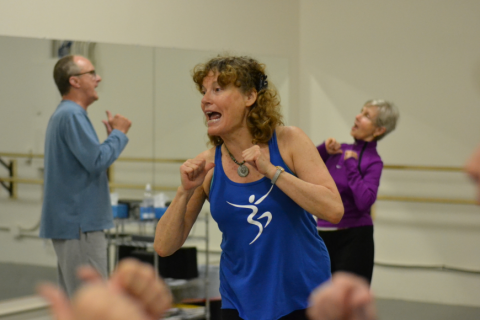
The Let Your Yoga Dance classes are tailored for people diagnosed with Parkinson's disease to stay active.
by: Amanda Morales Staff Writer of YourObserver.com
Published February 11, 2016

Megha-Nancy Buttenheim’s Let Your Yoga Dance for Parkinson’s class isn’t focused on perfecting a tree or downward dog pose. The smiles on the faces of her students are better than perfection.
“Unfortunately, yoga alone doesn’t fill up the joy quotient," Buttenheim said. "My job is all about building up the joy.”
Through the Neuro Challenge Foundation for Parkinson’s in partnership with Karma Yoga Outreach at Garden of the Heart Yoga Center, individuals with Parkinson's disease and their partners were able to attend a 12-week series of classes at the Sarasota Ballet Studio. When Buttenheim began teaching her Let Your Yoga Dance classes more than 20 years ago, the class attracted students looking for more than the traditional yoga exercise experience.
Let Your Yoga Dance incorporates traditional and modified yoga poses along with elements of theater through songs and dances. The concept came to Buttenheim more than 20 years ago during her 12-year stay at the Kripalu Center for Yoga and Health. It became a way for her to merge her background in theater and dance with the chakras or the body’s energy centers she learned through yoga.
The class wasn't focused on Parkinson's disease, but in 2000, several students told Buttenheim that they were diagnosed with the degenerative disease.
“I just noticed that in this one given year, so many people had this in common,” Buttenheim said.
With no formal medicine background, Buttenheim picked up a “Parkinson’s for Dummies” book and consulted with instructors of other dance-related classes tailored specifically to benefit people with Parkinson’s, which presents challenges that include tremors, stiffness of muscles, slowed body movements, and difficulty with balance.
“Dance is one of the finest modalities for Parkinson’s, especially if the cognition is involved and socialization is involved,” Buttenheim said.
She modified her class to be able to cater to the needs of her students with Parkinson’s disease. This included yoga positions that can be done while sitting in a chair. Buttenheim added songs and movements similar to what they would receive in physical therapy to exercise their vocal chords and throats.
“Physical therapy without music can possibly be uninspiring,” Buttenheim said. “But if you’re dancing and there’s music lighting up the brain, people get excited and sometimes their tremors fade away.”
Darwin Perry is among the students participating in the 12-week series. He attends both Buttenheim's classes and other yoga classes with his wife, Susan.
“It’s really to keep us moving.” Perry said. “Staying active is the biggest antidote.”
Since his diagnosis two years ago, Perry has noticed changes like his right foot dragging and has difficulty swallowing. Buttenheim reminds her students throughout the class to work their facial muscles — by smiling.
“You’re not as expressive anymore,” Perry said. “You have to remind yourself to smile.”
Buttenheim begins her classes with students seated in a circle and has them introduce themselves with a hand motion while they project their voices across the room. This allows them stretch their vocal chords and also to get to know one another.
Aside from the actual diagnosis of Parkinson’s the class addresses the isolation that often results from disorder.
Mara and Tom Eckhardt are seasonal residents in Sarasota and appreciate the support they get there from the local Parkinson’s community. Tom was diagnosed in July 2013. He finds that he benefits from the movement, serenity and flexibility he gets from the class.
“It has brightened our lives so much,” Mara Eckhardt said.
The experience levels and ranges of motion vary in the class. Buttenheim encourages her students to do the exercises in whatever form they’re most comfortable, whether it’s sitting or standing or using the ballet barre for support.
“If they stop moving because of fear, then they can get stuck in a chair,” Buttenheim said. “Fear and breath can’t live in the same place.”
